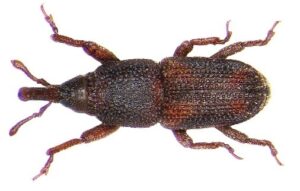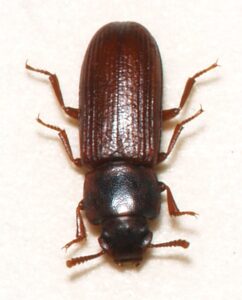-
-
- Mediterranean Flour Moth
General Description
· The adult is about 1 cm long. The distance between the two ends of the flat front wings is 2.5 cm. The color of the forewings is light gray, each with two brown stripes. The hindwings are white with gray flanks and long fringes on the forewings and hindwings. · The larva is pale yellow or pink in color. On the body, there are small black tubercles, from which long hair appears, and the color of the head is dark brown. When fully grown, it is about 1.5 cm.
· The egg is oval in shape, and white in color, and on its shell from the outside are simple protrusions resembling adjacent circles.
 Credit: Andy Reago & Chrissy McClarren
Credit: Andy Reago & Chrissy McClarrenLife Cycle and Common Characteristics
- The female lays eggs individually in accumulations of flour or other milled products.
- The female lays about 200-300 eggs. The eggs hatch after about a week into larvae that begin weaving threads, starting at the third larval stage.
- The duration of the larval stage is from 4-6 weeks. Before turning into a pupal stage, the color of the larva becomes dark green.
- The pupal stage is from 8-14 days.
- The duration of the generation is 7-18 weeks, and it has 3 generations per year.
Damage and Economic Implications
- The larvae feed on dried fruits and pollen in beehives. They are found in grain and its products. They can adapt and reproduce at 1% relative humidity.
- The larvae make tunnels in the foodstuffs that infect them and secrete thick silky threads on them that stick the particles of the food together and turn them into adjacent masses that are difficult to remove or clean.
-


 Credit:
Credit: 
